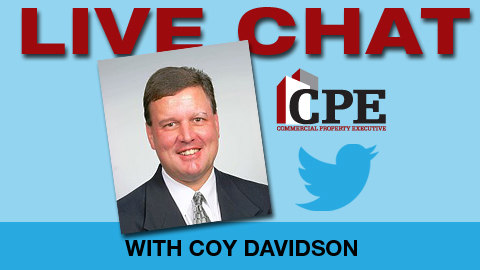Twitter Chat: Coy Davidson on Medical Office Development & Hospital Systems
Medical office development and hospital systems expert Coy Davidson, a senior vice president at Colliers International, shared his knowledge on the healthcare sector and medical office buildings during a live Twitter chat with CPE editors in 140 characters or less per Tweet. Davidson has been directly involved in more than 4 million square feet of office…
Medical office development and hospital systems expert Coy Davidson, a senior vice president at Colliers  International, shared his knowledge on the healthcare sector and medical office buildings during a live Twitter chat with CPE editors in 140 characters or less per Tweet.
International, shared his knowledge on the healthcare sector and medical office buildings during a live Twitter chat with CPE editors in 140 characters or less per Tweet.
Davidson has been directly involved in more than 4 million square feet of office lease and sales transactions and more than 700 acres of commercial land site deals for a wide variety of clients, ranging from Fortune 500 corporations to Houston-based firms and small businesses. What follows is a transcript of the exchange.
CPE: Coy, what is population health management? What does it mean for real estate and consumers?
Davidson: Population health management has to do with systems and policies that affect healthcare quality and outcomes, ultimately improving healthcare for the total population.
CPE: How does retail play into the healthcare real estate industry?
Davidson: Healthcare providers are looking to provide easier access to consumers, off campus and in suburban settings, so retail is becoming increasingly popular with providers.
CPE: Why are physician practices in high demand with hospital systems?
Davidson: Cost pressures are putting the focus on increasing market share and increasing referrals, so physician practices play a key role to achieve that objective. Many independent physicians are moving to the hospital employment model.
Barbi Reuter (Twitter follower): Do you see more healthcare practices/systems outsourcing their real estate?
Davidson: Barbi, yes, CRE is becoming more important to healthcare providers, so they are looking for expertise.
CPE: With so much new construction, what is happening to antiquated hospital facilities?
Davidson: Hospitals are looking to repurpose antiquated facilities to alternative services and outpatient facilities, as an example, converting acute care into long-term acute care.
CPE: What’s new in medical office development?
Davidson: There is more off-campus development, pushing out to the consumer in the suburbs; there’s more LEED construction, bigger open floor plates, and also more outpatient and specialized facilities such as freestanding emergency departments, physician hubs.
PetersonBlissAdvisor (Twitter follower): What about adapting retail uses, only for general practice/non-specific uses?
Davidson: Increasingly, we are seeing retail uses converting to healthcare.
CPE: What is the difference between a freestanding emergency department and an urgent care facility?
Davidson: Level of service makes the difference. Freestanding emergency departments can treat life- and limb-threatening cases. Urgent care is immediate care but for non-life-threatening situations and a less-expensive service.
CPE: Why is this distinction important?
Davidson: The distinction is important because of cost and insurance reimbursements. You don’t need an emergency department for a few stitches. Emergency department is a costlier service. Urgent care is to see a doctor for immediate care but for less serious issues.
Colliers AZ News (Twitter follower): Is investment interest on the rise in the medical office market?
Davidson: Yes, medical office is a favored asset class among investors and on the rise. The competition is fierce for high-quality MOB assets.
CPE: What is the impact of the Affordable Care Act on the healthcare real estate industry?
Davidson: The impact is still somewhat fuzzy, but estimates say there will be 32 million new insured consumers, which equates to the need for more services, physicians and expected increased demand for real estate for healthcare. Also, the aging boomer population is a driver for more healthcare demand and more real estate to provide healthcare.
Reuter: What percentage of your healthcare clients are demanding green building features/LEED certification?
Davidson: Barbi, it’s not so much that they are demanding but increasing emphasis. Cost still plays a role.
CPE: How have medical office building cap rates changed?
Davidson: On campus MOBs have historically traded at lower cap rates, but with so much new suburban development, if the MOB is hospital system sponsored (i.e., credit), those cap rates now mirror on-campus MOB cap rates.
CPE: Coy, thank you so much for your informative input as a guest on CPE’s Twitter chat.
Davidson: Thank you very much for having me as a guest.







You must be logged in to post a comment.